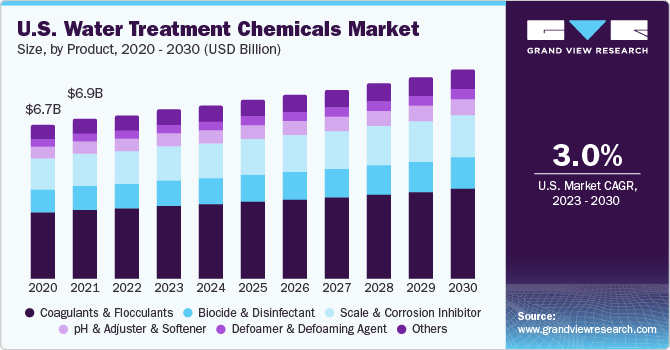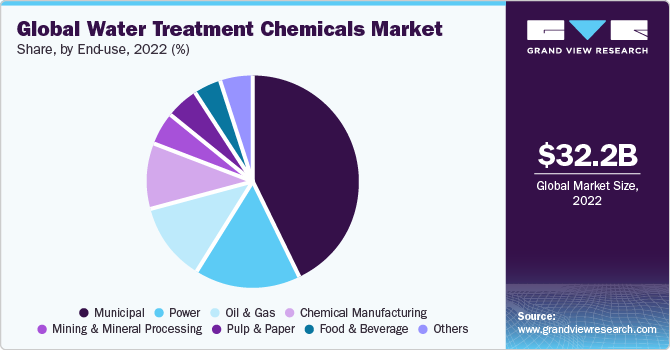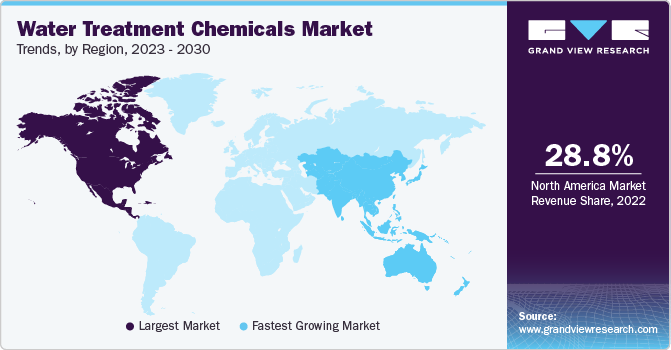
Water Treatment Chemicals Market Size, Share & Trends Analysis Report By Product (Coagulants & Flocculants, Biocide & Disinfectant, Scale & Corrosion Inhibitor), By Application, By End-use, By Region, And Segment Forecasts, 2023 - 2030
- Report ID: GVR-4-68038-584-7
- Number of Report Pages: 97
- Format: PDF
- Historical Range: 2018 - 2021
- Forecast Period: 2023 - 2030
- Industry: Bulk Chemicals
Market Size & Trends
The global water treatment chemicals market size was valued at USD 32.2 billion in 2022 and is anticipated to grow at a compound annual growth rate (CAGR) of 3.8% from 2023 to 2030. The growth can be attributed to increasing requirements from sugar and ethanol, fertilizers, geothermal power generation, petrochemical manufacturing, and refining industries, specifically in emerging economies. The increase in demand for developing a centralized facility for fluid treatment units for medium and small-scale manufacturers for complete in-situ processes attaining zero discharge is the prominent trend prevailing in the market. The market is expected to witness promising growth in the Middle East and Africa owing to the growing adoption of saline water treatment in order to fulfill the increasing water demand. Desalination is the most prominent technology used in different parts of the Middle East. Saudi Arabia is largely dependent on desalination to meet their water requirements.

End-use Insights
The municipal segment accounted for the largest revenue share of around 43.1% in 2022 owing to extensive usage of the chemicals for industrial and municipal wastewater treatment applications. Growing water scarcity in the developed economies of Europe and North America has pushed the major players to focus on reusing and recycling water.

The increasing charge on waste treatment by the municipalities has further provided an impetus for the industrialist to establish or improve their wastewater treatment and reuse facilities. Strength chemicals find its application in fluid treatment for emulsion breaking, sludge dewatering, and flocculation among others.
The oil & gas segment is expected to register a CAGR of 3.7% over the forecast period. Petroleum refineries and chemical plants use steam and water for a variety of processes ranging from desalination process to fluid catalytic cracking units, cooling towers, and steam generators. The scarcity of clean water has led to the need for efficient treatment processes in order to carry out sustainable and reliable operations in petroleum refineries and chemical plants. This is anticipated to boost the demand for chemicals in oil & gas end-use over the forecast period.
Regional Insights
North America dominated the market and accounted for the largest revenue share of 28.8% in 2022. The advancements in hydraulic fracturing technology have led to increased production of unconventional energy sources such as shale gas and tight oil, primarily in North Dakota and West Texas regions of North America. Consequently, there has been a growing demand for water treatment facilities within the upstream oil and gas sector.

The U.S. is anticipated to grow at a CAGR of 3.0% over the forecast period. This growth can be attributed to stringent government regulations intended for monitoring the disposal and production of wastewater. According to the International Trade Administration (ITA), the U.S. is a leader in the production, consumption, and supply of energy (presence of thermoelectric power plants). Mounting demand for treatment chemicals from the U.S. power industry to treat its wastewater is expected to positively impact market growth.
Asia Pacific is expected to grow at a CAGR of 4.4% during the forecast period. The growth of the industrial, power, and manufacturing sectors is anticipated to augment the demand for boiler chemicals and systems in the emerging economies of Asia Pacific in the near future. The presence of suspended particles and heavy metals has led to increased demand for pretreated water in China. China Water Risk (CWR) works for several government bodies in the country and globally. CWR briefs about the risks and the impact of wastewater generated from the mining, food & beverages, power, textiles, and agriculture sectors in China. The reports published by CWR are proven to be instrumental concerning challenges and are, thus, contributing to water treatment activities in the country.
In December 2020, Buckman announced the inauguration of the Buckman Center of Excellence, situated at the esteemed International Center for Clean Water (ICCW) in Chennai, India. The state-of-the-art facility will serve as a hub for collaboration between Buckman scientists and esteemed local academic institutions. Notably, collaborative efforts will be conducted alongside distinguished researchers from the renowned Indian Institute of Technology Madras (IIT Madras), with a focus on advancing chemistry-based innovations specifically catered to the water market.
Product Insights
The coagulants & flocculants segment accounted for the largest revenue share of 38.2% in 2022 as most of the treatment plant includes the sedimentation process. Coagulation and flocculation are mostly used in the tank of chemical products of oil and gas plants. The coagulation process fastens the sedimentation process. The coagulants are in the form of organic and inorganic compounds such as aluminum hydroxide chloride and aluminum sulfate. The reason for adding coagulants is to remove 90% of the suspended solid particles from the wastewater during the treatment process.
The biocides and disinfectants segment is expected to grow at a CAGR of 4.0% during the forecast period. Biocides and disinfectants ensure the safety of manufacturing systems and maintain operational efficiency by the prevention of hazardous microbial growth, and reduce biofouling and contamination. The safe control of microbiological activity is a critical aspect of manufacturing and industrial processes.
Biocides and disinfectants are used to ensure correct water conditions are achieved for feed, waste, and reusable treated water. They are used in the sugar and ethanol sector to ensure that correct conditions are achieved for wastewater. In addition, biocides are broadly used for the control of bacteria in the ethanol fermentation process.
Application Insights
The raw water treatment segment held the largest revenue share of 48.2% in 2022 owing to growing utilization in industrial settings for cooling, product formulations, rinsing, or even human consumption if it is properly purified. It is used for the pretreatment of sourced water in order to improve process performance and product efficiency for a particular application. It is focused on protecting industrial equipment from corrosion, scaling and fouling, and any other form of damage. The process may vary from one another as they are designed according to specific treatment needs. The process will usually include coagulation, flocculation, sedimentation, filtration, disinfection, and distribution.
The boiler segment is expected to grow at a CAGR of 4.2% over the forecast period. Boilers emerged as the prominent application segment on account of their extensive utilization in the petrochemical industry. Boiler water treatment is used to safeguard the boiler components and piping from damage due to the presence of contaminants present in the boiler or feeds. These contaminants present may include suspended solids, organic material, such as aluminum, silica, copper, calcium, iron magnesium, dissolved gases hardness, and dissolved solids. Boiler feed water can result in fouling corrosion and scaling of the boiler and downstream equipment without proper boiler treatment, which can result in expensive maintenance fees, plant downtime, boiler failure, and increased fuel consumption.
Key Companies & Market Share Insights
The water treatment chemicals market is fragmented in nature. Manufacturers have a high degree of integration i.e. in-house raw material production facilities and long-term supply contracts with raw material suppliers. Products manufactured by the companies are sold in domestic and international markets through various distribution channels including direct supply agreements and third-party suppliers, which not only procure the finished products from the manufacturers but also distribute them across the region through an extensive product distribution network worldwide.
Furthermore, the business activities of the companies are extended to include control of the direct supply as well as manufacturing, distribution, and application of the product. Presence across various stages of the value chain has improved the profits of companies by reducing the cost of distribution and giving them better control over the pricing of their products.
Key Water Treatment Chemicals Companies:
- SUEZ
- BASF SE
- Ecolab
- Solenis
- Nouryon
- Kemira
- Baker Hughes Company
- Dow
- SNF
- Cortec Corporation
Recent Development
-
In January 2023, Kemira, a chemical solutions provider for water-intensive industries, completed the full acquisition of SimAnalytics. This strategic move enhances Kemira's ability to provide data-driven predictive services and machine learning solutions to support its customers' businesses effectively. Through this acquisition, Kemira strengthens its portfolio and reinforces its commitment to delivering advanced and tailored solutions to meet evolving industry needs.
-
In September 2022, SUEZ unveiled its strategic plan for the year 2027, outlining its objective to become a trusted partner in circular solutions for water and waste management. The plan emphasizes the company's commitment to value creation through the provision of established solutions, heightened innovation, and reinforced investment capabilities. By addressing mounting environmental challenges faced by its clients, SUEZ aims to establish itself as a leading contributor in the industry. To realize this vision, the company has set forth a clear and ambitious growth strategy, targeting annual revenue growth of 4 to 5 percent by 2027. This objective will be supported by significant investment capabilities and a noteworthy 50 percent increase in research and development efforts.
Water Treatment Chemicals Market Report Scope
|
Report Attribute |
Details |
|
Market size value in 2023 |
USD 33.31 billion |
|
Revenue forecast in 2030 |
USD 43.53 billion |
|
Growth rate |
CAGR of 3.8% from 2023 to 2030 |
|
Base year for estimation |
2022 |
|
Historical data |
2018 - 2021 |
|
Forecast period |
2023 - 2030 |
|
Quantitative units |
Revenue in USD million/billio and CAGR from 2023 to 2030 |
|
Report coverage |
Revenue forecast, company ranking, competitive landscape, growth factors, and trends |
|
Segments covered |
Product, end-use, application, region |
|
Regional scope |
North America, Europe, Asia Pacific, Central & South America, MEA |
|
Country scope |
U.S.; Canada; Mexico; UK; Germany; France; Italy; Spain; China; Japan; India; South Korea; South East Asia; Brazil; Colombia; Azerbaijan; Uzbekistan; Turkey; Turkmenistan; Iran; Kazakhstan; Georgia |
|
Key companies profiled |
SUEZ; BASF SE; Ecolab; Solenis; Nouryon; Kemira; Baker Hughes Company; Dow; SNF; Cortec Corporation |
|
Customization scope |
Free report customization (equivalent up to 8 analyst’s working days) with purchase. Addition or alteration to country, regional & segment scope |
|
Pricing and purchase options |
Avail customized purchase options to meet your exact research needs. Explore purchase options |
Global Water Treatment Chemicals Market Report Segmentation
This report forecasts revenue growth at global, regional, and country levels and provides an analysis of the latest industry trends in each of the sub-segments from 2018 to 2030. For this study, Grand View Research has segmented the global water treatment chemicals market based on product, end-use, application, and region:

-
Product Outlook (Revenue, USD Million, 2018 - 2030)
-
Coagulants & Flocculants
-
Biocide & Disinfectant
-
Defoamer & Defoaming Agent
-
pH & Adjuster & Softener
-
Scale & Corrosion Inhibitor
-
Others
-
-
End-use Outlook (Revenue, USD Million, 2018 - 2030)
-
Power
-
Oil & Gas
-
Chemical Manufacturing
-
Mining & Mineral Processing
-
Municipal
-
Food & Beverage
-
Pulp & Paper
-
Others
-
-
Application Outlook (Revenue, USD Million, 2018 - 2030)
-
Raw Water Treatment
-
Water Desalination
-
Cooling
-
Boiler
-
Effluent Water Treatment
-
Others
-
-
Regional Outlook (Revenue, USD Million, 2018 - 2030)
-
North America
-
U.S.
-
Canada
-
Mexico
-
-
Europe
-
UK
-
Germany
-
France
-
Italy
-
Spain
-
-
Asia Pacific
-
China
-
Japan
-
India
-
South East Asia
-
South Korea
-
-
Central & South America
-
Brazil
-
Colombia
-
-
Middle East and Africa
-
Azerbaijan
-
Uzbekistan
-
Turkey
-
Turkmenistan
-
Iran
-
Kazakhstan
-
Georgia
-
-
Frequently Asked Questions About This Report
b. North America dominated the water treatment chemicals market with a share of 28.8% in 2022. This is attributable to growing shale gas production resulting in increased penetration of water treatment facilities in the upstream oil & gas sector.
b. Some key players operating in the water treatment chemicals market include Suez, Nouryon, Kemira Oyj, Ecolab, Solenis, Kurita Water Industries, Ltd, Solvay, SNF Floerger, and Dow Chemicals.
b. Key factors that are driving the market growth include stringent regulatory framework concerning the environment along with growing necessity for chemically treated water from end-use sectors such as chemical, oil & gas, and municipal water treatment.
b. The global water treatment chemicals market size was estimated at USD 32.2 billion in 2022 and is expected to reach USD 33.31 billion in 2023.
b. The global water treatment chemicals market is expected to grow at a compound annual growth rate of 3.8% from 2023 to 2030 to reach USD 43.53 billion by 2030.
We are committed towards customer satisfaction, and quality service.
"The quality of research they have done for us has been excellent."




